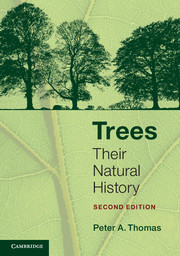Book contents
- Frontmatter
- Epigraph
- Contents
- Preface
- Chapter 1 An overview
- Chapter 2 Leaves: the food producers
- Chapter 3 The trunk and branches: more than a connecting drainpipe
- Chapter 4 Roots: the hidden tree
- Chapter 5 Towards the next generation: flowers, fruits and seeds
- Chapter 6 The growing tree
- Chapter 7 The shape of trees
- Chapter 8 The next generation: new trees from old
- Chapter 9 Age, health, damage and death: living in a hostile world
- Chapter 10 Trees and us
- Further Reading
- Index
- References
Chapter 1 - An overview
Published online by Cambridge University Press: 05 July 2014
- Frontmatter
- Epigraph
- Contents
- Preface
- Chapter 1 An overview
- Chapter 2 Leaves: the food producers
- Chapter 3 The trunk and branches: more than a connecting drainpipe
- Chapter 4 Roots: the hidden tree
- Chapter 5 Towards the next generation: flowers, fruits and seeds
- Chapter 6 The growing tree
- Chapter 7 The shape of trees
- Chapter 8 The next generation: new trees from old
- Chapter 9 Age, health, damage and death: living in a hostile world
- Chapter 10 Trees and us
- Further Reading
- Index
- References
Summary
What is a tree?
Everyone knows what a tree is: a large woody thing that provides shade. Oaks, pines and similarly large majestic trees probably come immediately to mind. Such big trees are characterised by the enormous changes in size from seed to mature tree: a mature giant sequoia (Sequoiadendron giganteum) is a billion, billion times heavier than the seed it came from (that’s 1 with 12 zeros after it). A stricter, but more inclusive, botanical definition is that a tree is any plant with a self-supporting, perennial woody stem (i.e. living for more than 1 year). The first question that normally comes back at this point is to ask what then is a shrub? To horticulturalists, a ‘tree’ is defined as having a single stem more than 6 m (20 ft) tall which branches at some distance above ground, whereas a shrub has multiple stems from the ground and is less than 6 m. This is a convenient definition for those writing tree identification books who wish to limit the number of species they must include. In this book, however, shrubs are thought of as being just small trees since they work in exactly the same way as their bigger neighbours. Thus, ‘trees’ cover the towering giants over 100 m through to little sprawling alpine willows no more than a few centimetres tall.
Some plants can be clearly excluded from the tree definition. Lianas and other climbers are not self-supporting (although some examples are included in this book), and those plants with woody stems which die down to the ground each year, such as asparagus, do not have a perennial woody stem. Bananas are not trees because they have no wood (the trunk is made from leaf stalks squeezed together). Nor are bamboos since they are just hardened grasses even though they can be up to 25 m tall and 25 cm thick (see Box 1.1).
- Type
- Chapter
- Information
- TreesTheir Natural History, pp. 1 - 12Publisher: Cambridge University PressPrint publication year: 2014

